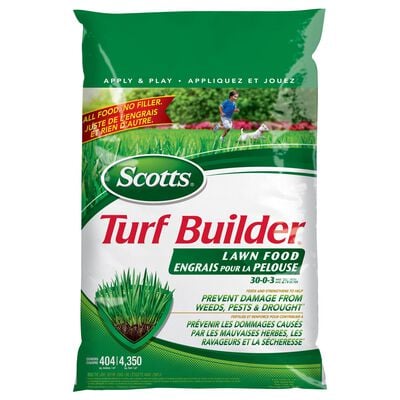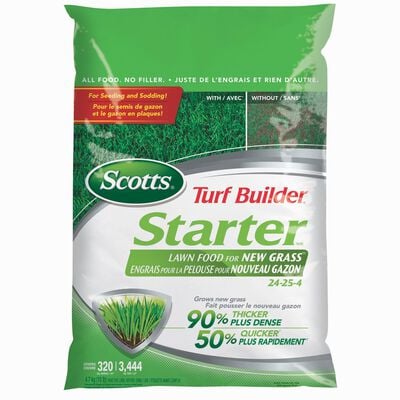
The Questions People Ask Most About Grass Seed
Confused About Grass Seed?
You're not alone. It's easy to get confused about grass seed. What kind of seed to use, how to plant it, and even weather conditions can all add up to one big question mark for many people. That's why we had our experts answer some of the most commonly asked questions about planting grass seed.
General Questions About Grass Seed
What Spreader Settings Should I Use? I Planted My Grass Seed and It Didn't Grow. What's Wrong?What Is Overseeding or Reseeding? Why Should I Do It? How Long Can I Store Grass Seed before It Goes Bad?
Buying Grass Seed
Where Can I Buy Scotts® Grass Seed?How Much Grass Seed Should I Buy?
Planting Grass Seed
How Do I Plant Grass Seed? When Is the Best Time to Plant Grass Seed? Can I Plant New Grass AFTER Using a Weed Control Product? (i.e. weed preventer or weed control) Why Should I Use a Starter Fertilizer? How Long Does It Take for Grass to Begin Growing? Should I Put Straw Down to Protect the Grass Seed?
Caring for Newly Planted Grass
How Much Do I Need to Water My New Grass? How Soon Can I Mow After Planting New Grass? When Can I Use Weed Control Products (i.e. Weed Preventer or Weed Control) on My New Grass? Do You Have Additional Questions?
General Questions About Grass Seed
What Spreader Settings Should I Use?
Spreader settings can vary, depending on what grass seed type and spreader you are using.
For Scotts® Turf Builder® Grass Seed Go to the Scotts® Turf Builder® Grass Seed product page, click on the product you're interested in, and then click on the Details and Usage tab. You'll find your spreader settings there.
I Planted My Grass Seed and It Didn't Grow. What's Wrong?
There are many things that could have happened. Too much or too little water, weather conditions, use of weed control products, and/or poor soil conditions can all be possible causes. Because each situation is different, it is best to call and speak with one of our experts to help diagnose the problem. 1-800-543-TURF (8873)
What Is Overseeding or Reseeding? Why Should I Do It?
Overseeding simply means spreading grass seed over an existing lawn to thicken the turf and fill in bare/thin spots. Over time, seasonal stresses such as heat, drought, winter conditions, and pests can cause your grass to deteriorate. If your lawn is just thin or damaged, overseeding is a fast, inexpensive way to help bring your lawn back to its lush, green, healthy self without tearing everything out and starting over.
This article provides an easy how-to guide on reseeding.
How Long Can I Store Grass Seed Before It Goes Bad?
If stored in a cool, dry place, grass seed can last for 2-3 years. However, the germination rate (the number of seeds that will grow) will decrease over time, so you may not get the same results you would if you were using fresh seed. For best results, use fresh product and try to plant it within a year.
Buying Grass Seed
Where Can I Buy Scotts® Grass Seed?
Our products can be found at most home improvement centers, mass merchants, hardware stores, and garden centers.
How Much Grass Seed Should I Buy?
First you need to know the size of the area you want to plant. If you already know how many square feet you are seeding, then proceed to Step 2.
Step 1:
Sometimes it's hard to guess how big your lawn is just by looking at it. Square footage adds up fast. To help you estimate how much lawn you have, compare it to the examples on this helpful
Step 2:
Once you know the square footage, the next step is to look at the package to determine how many bags you need to buy. There are usually 2 coverage numbers listed on a grass seed package:
1: Reseeding (Overseeding) Rate: The higher of the two coverage numbers is typically what's called the Overseeding Rate. This is how many square feet the package would cover if you were reseeding, or spreading grass seed across all or most of your existing lawn.
2: New Lawn Rate: The lower of the 2 coverage numbers is normally the new lawn rate. This is how many square feet the package would cover if you were repairing bare spots or planting a new lawn from scratch.
It's important to read each grass seed package carefully to make sure you buy the right amount.
All Scotts grass seed products have the coverage listed on the package. The number on the front of the package is usually the Overseeding coverage. The new lawn coverage can be found on the back of the bag.
Planting Grass Seed
How Do I Plant Grass Seed?
We have several how-to videos and articles on our website to help with your seeding project. Here are a few of the most popular topics:
Important Steps to Seeding A New Lawn (Article)How To Repair & Seed Bare Spots in the Lawn (Article)Revive Your Lawn by Overseeding (Article)Seeding a Lawn From Scratch (Article)Patching Your Lawn (Video)Overseeding Your Lawn (Video)Calibrating Your Spreader (Video)Or
Click here for a link to all of our seeding project resources
When Is the Best Time to Plant Grass Seed?
Grass seed grows best when temperatures are between 15-20 degrees celsius. Early fall is the best time to seed because of its shorter days, cooler nights, and heavier dews. Your most successful seeding time is right around Labor Day. Seeding 2 weeks before or after that easy-to-remember holiday gives your new seedlings time to build strong roots before the winter. Spring is also a great time to plant grass seed because of its moderate temperatures and heavier rainfall.
Can I Plant New Grass AFTER Using a Weed Control Product? (i.e. Weed Preventer or Weed Control)
All weed control products are different, but in general, it is not recommended to plant new grass within 4 months of using a weed preventer, or within 1 month of using other weed control products. Always refer to the product label for specific information related to the weed control product you are using.
Why Should I Use a Starter Lawn Food?
Scotts® Turf Builder® Starter Food for New Grass provides your new grass with the nutrients it needs to build strong roots. As a result, your new grass will grow in faster and thicker than if you didn't feed it at all.
How Long Does It Take for Grass to Begin Growing?
The length of time varies by grass type. The product package should tell you how long it will take for your new grass to begin growing. For the general guidelines used by Scotts experts, click here.
Should I Put Straw Down to Protect the Grass Seed?
Using straw to cover newly seeded areas is not recommended. Some straw may contain weeds and unwanted plant seeds that can invade your lawn. We recommend putting down a thin layer of
Scotts® Turf Builder® LawnSoil™ evenly over prepared area. Next, spread grass seed and lightly rake into soil.
Caring For Newly Planted Grass
How Much Do I Need to Water My New Grass?
Watering is crucial for seeding success. Water twice daily (or more if conditions are extremely hot/dry) to ensure the top 1 inch of soil stays moist. Continue watering daily until you have mowed the new grass 1-2 times. Once your new grass is established, you can go back to a normal watering routine.
How Soon Can I Mow After Planting New Grass?
If you planted seed on bare ground, avoid mowing until the new seedlings have reached a height of 3 or 3 1/2 inches. Mow on a dry day and make sure the mower blade is sharp to avoid damaging the new grass blades. If you reseeded your lawn (applied grass seed over all or part of your existing lawn), you can continue to mow as needed, but try to limit the frequency to reduce traffic on the new seedlings.
When Can I Use Weed Control Products on My New Grass? (i.e. Weed Preventer or Weed Control)
All weed control products are different, but in general, it is recommended to wait until the new grass has been mowed at least 3 times before using a weed preventer or other weed control products. Always refer to the product label for specific information related to the weed control product you are using.
Do You Have Additional Questions?
Help is only a phone call away! 1-800-543 TURF (8873)

